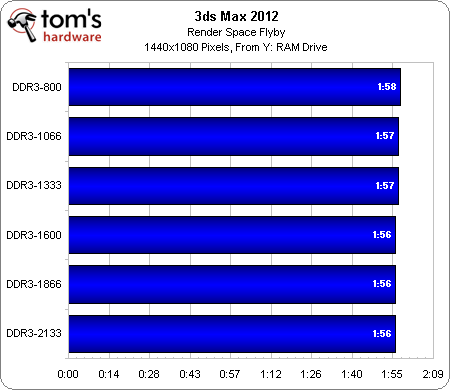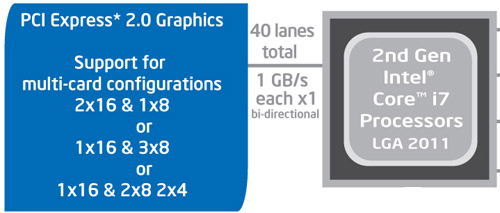Intel Core i7-3960X Review: Sandy Bridge-E And X79 Express
Intel's Sandy Bridge design impressed us nearly a year ago, but it was intended for mainstream customers. The company took its time readying the enthusiast version, Sandy Bridge-E. Now, the LGA 2011-based platform and its accompanying CPUs are ready.
Quad-Channel Memory And PCI Express 3.0
Quad-Channel Memory Control
All three models sport the same quad-channel memory controller officially rated for data rates as high as 1600 MT/s. That’s up to 51.2 GB/s of bandwidth, in theory.
Although we used Intel’s DX79SI motherboard for all of the performance benchmarking in this piece, the platform had a hard time scaling beyond DDR3-1600 using any of the quad-channel kits in our lab. So, I swapped into an Asus Rampage IV Extreme that arrived a little later, and used a set of G.Skill Ripjaws Z F3-17000CL9-4GBZH modules rated for DDR3-2133 to test scaling.
Jumping from DDR3-800 to -1066 to -1333 and then -1600 yields impressive throughput gains, reflected in some solid performance improvements (WinRAR) and other, less notable speed-ups (3ds Max).
For now, my recommendation is to grab the lowest-latency quad-channel DDR3-1600 kit for which you’re willing to pay. Thomas is already working on our first high-end memory round-up aimed specifically at X79, though, which promises to shed more light on the sensibility of the kits with gobs of headroom for overclocking.
PCI Express 3.0
Sandy Bridge-E’s memory capabilities are decidedly more relevant in the server space. However, the design’s PCI Express connectivity might appeal to power users with an affinity for multi-card graphics subsystems.
Get Tom's Hardware's best news and in-depth reviews, straight to your inbox.
One of the most controversial points in my Sandy Bridge-E preview was the fact that PCI Express 3.0 was stated "not supported" by the manufacturer of my test platform. Multiple outside sources indicated that third-gen PCIe was planned, but wouldn’t be available, possibly until 2012.
It turns out that PCI Express 3.0 is, in fact, supported by Sandy Bridge-E (and the preview was updated to confirm 8 GT/s support the day after it went live). But because there weren’t (and still aren’t) any third-gen devices available yet, validating the feature was problematic. In fact, as you can see in the image below, Intel is still only officially guaranteeing that PCI Express 2.0 works, and probably will continue to do so until we see some hardware with a third-gen interface.
Nevertheless, Intel’s Core i7 datasheet confirms PCI Express 3.0 compliance, enabling up to 1 GB/s of bandwidth per lane, per direction.
Forty lanes of connectivity are built into all three Sandy Bridge-E-based processors, divisible into as many as 10 different ports. Most motherboard vendors will probably configure their platforms for three or four graphics cards, resulting in two x16 slots and one x8 slot, or one x16 link and a trio of x8 connectors.
Compared to Sandy Bridge and its 16 lanes of second-gen PCIe on each CPU, Sandy Bridge-E’s 40 lanes are downright decadent. But don’t expect that improvement alone to yield better gaming performance with multiple GPUs installed. After all, we’ve already proven that you can get exceptional performance from three graphics cards with a three-part series on the matter. At least until we’re able to test with PCI Express 3.0-capable devices, there’s no reason to demand the connectivity Sandy Bridge-E offers when an LGA 1155 platform equipped with Nvidia’s NF200 bridge isn’t even starved for throughput.
Where Sandy Bridge-E could positively impact gaming performance is with its enhanced processing power. Nvidia says the CPU’s speed-up is able to maximize scaling with three of its GeForce cards installed, and we’ll be testing that claim shortly. PCI Express isn’t credited with the improvement, though. The six Sandy Bridge cores and big L3 cache get that honor.
Current page: Quad-Channel Memory And PCI Express 3.0
Prev Page Say Hello To The PC Hardware Trophy Wife Next Page X79 Express: P67, Is That You?-
SpadeM So no SAS/Full Sata 3 ports but u do get PCIe 3 ... no Quicksync but u do get 2 more cores and the added cache ... no USB 3.0 but u get quad channel memory which in real life every day computing is a minimal gain at best. Feels an awful lot like a weak trade if you ask me. I'm basically asked to buy the P67 chipset with sprinkles on top. And for 1000$ it feels like it falls short. For heavy workloads it's cheaper and faster to make yourself 2 systems based on 1155 or bulldozer and render, fold, chew numbers that way. X79 should have launched with an ivy bridge based cpu inside and a better chipset to live to it's name.Reply
What we have today is simply a platform for bragging rights not a serious contender to the X38, X48, X58 family. -
illfindu Not to take the review to much off topic but its worth bringing up because this review was so complete , as in covering a vast array of situations and programs. Its truly embarrassing for AMD that the FX-8XXX series is beaten not only bye chips with half the cores but half the cores that are a generation behind. In fact as of this moment the FX set is almost inspiring it its lack of any value at first glance at some of these marks one could say that AMD's most expensive chip at over 200$ is one of its slowest being beaten bye both the x4 and x6 phenoms.Reply -
redsunrises Illfindu, you are beating a dead horse... Old news, lets move on (sorry, just tired of the same thing being said over and over, which will end in an amd fanboy fight). Great review though!Reply -
ohim This article tells me 2 things , either our current software is a total piece of crap since it has absolutely no clue of multi core cpus, or the future without AMD is so grim that intel makes you pay 1000 bucks for a cpu that doesn`t perform really that fast ... but for sure the software industry needs to take a better look at those multicore optimisations.Reply -
stonedatheist I think Intel would be raking in the dough if they left all 8 cores enabled for the 3960X. I doubt that a later revision will enable them. 8c/16t will probably hit the desktop with IB-E (can't wait) :)Reply -
joytech22 :| Well AMD is fighting a losing battle.. (In High-End CPU's, which I actually use for rendering etc..)Reply
I would LOVE to see them pick up their game and provide me with a worthy upgrade over my 4GHz i7 2600 (Non-K). I would swoop it up.
Look, BD had 4 modules with two "cores" each, each module is equivalent to a Sandy Bridge core.
They should just combine both of those cores or make them a single core, so we get 4 threads.
Then create 4-6-8 core versions of those CPU's..
Think about it.. the FX8150 is more of a 4-core CPU where the resources are halved pretty much so you get two threads per core, it would have been MUCH MUCH better if they just kept 4 strong cores.
Not sure why either but I always seem to start an AMD related comment :\ -
JeanLuc Hi Chris,Reply
The labels are wrong on the graphs on this page the last ones should read DDR2-2133 on the last two shouldn't it?
JeanLuc




